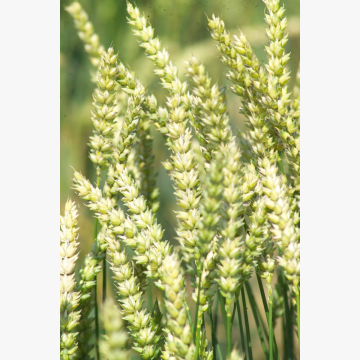FOR CONSULTATIONS APPLY TO:
Commercial director
Lina Smalskienė
tel. +370 618 02 551
e-mail linak@agrolitpa.lt
Sales manager
Tautvydas Kliučininkas
tel. +370 681 35 093
e-mail tautvydask@agrolitpa.lt
Sales manager
Eglė Petkevičienė
tel. +370 626 95 458
e-mail eglep@agrolitpa.lt
Sales manager
Kotryna Nakrošytė
tel.: +370 601 39 282
e-mail kotryna@agrolitpa.lt
ZENON
A medium-late excellently yielding spring wheat whit grain quality class E
- Excellent yield, treated and untreated
- Medium-short, but very stiff straw
- Excellent quality
- Outstanding protein content and protein yield
- Decent disease resistance package with excellent Septoria tolerance
- Decent Fusarium-resistance
- Decent Hagberg falling number
The variety is included to the list of recommended varieties in Finland in 2017
- Food type, E quality class. High falling number
- Very suitable for organic farms
- High yields both with and without seed treatment
- Resistant to many diseases
- Very resistant to lodging
- Very high protein content
- Yield potential without seed treating – 7.5 t/ha
- Yield potential with seed treatment – 7.9-9.28 t/ha
- Maturation time – medium
- Plant height – medium (79-98 cm)
- Resistance to lodging – very high
- Resistance to diseases – high
- Resistance to powdery mildew – 7 points (when 9.0 – very resistant)
- Resistance to yellow rust – 7 points (when 9.0 – very resistant)
- Resistance to brown rust – 7 points (when with 9.0 – very resistant)
- Resistance to ear fusariosis– 7 points (when 9.0 – very resistant)
- Resistance to septoria on leaves – 7 points (when 9.0 – very resistant)
- Weight of 1000 grains – 38.71-44.31 g
- Hectoliter weight – 79.4-81.5 kg/hl
- Protein content – 14.3%
- Protein yield – 1.22 t/ha
- Medium height (95-98 cm), but very strong stem
- Stem strength – 1.6 points (with 1 point – resistant to lodging, 9 points – not resistant to lodging)
- It is also possible to sow untreated seeds, it is very suitable for organic farms
- Yield without seed treating (1999-2016) – 7.5 t/ha
- Yield with seed treatment (1999-2016) – 7.9 t/ha
- Weight of 1000 grains – 41.3 g
- Hectoliter weight – 79.4 kg/hl
- High protein content - 14.3%
- Protein yield – 1.22 t/ha
- Sufficient resistance to septoria and fusariosis
- Susceptibility to powdery mildew – 4 points (when 1.0 – very resistant; 9.0 – very injured)
- Susceptibility to yellow rust – 4 points (when 1.0 – very resistant; 9.0 – very injured)
- Susceptibility to brown rust – 4 points (when 1.0 – very resistant; 9.0 – very injured)
- Susceptibility to septoriosis – 4 points (when 1.0 – very resistant; 9.0 – very injured)
- Sufficient falling number
According to the breeders of variety:
- Grain yield without seed treating – high (8 points out of 9)
- Grain yield with seed treatment – high (6 points out of 9)
- Time to heading – medium (6 points out of 9)
- Maturity time – medium (6 points out of 9)
- Plant height – medium (5 points out of 9)
- Very resistant to lodging (susceptibility to lodging 3 points out of 9, where 1 is erect and 9 is lodged)
- Low susceptibility to diseases
- Susceptibility to powdery mildew – 4 points (when 1.0 – very resistant; 9.0 – very injured)
- Susceptibility to yellow rust – 4 points (when 1.0 – very resistant; 9.0 – very injured)
- Susceptibility to brown rust – 4 points (when 1.0 – very resistant; 9.0 – very injured)
- Susceptibility to ear fusarium – 4 points (when 1.0 – very resistant; 9.0 – very injured)
- Susceptibility to septoriosis – 4 points (when 1.0 – very resistant; 9.0 – very injured)
- Tillering – good (5 out of 9)
- Number of grains in ear – high (8 points out of 9)
- Weight of 1000 grains – average (5 points out of 9)
- Protein content – very high (9 points out of 9)
- Grain hardness – very high (9 points out of 9)
- Sedimentation – very high (9 points out of 9)
- Falling number – moderately high (7 points out of 9)
- The stability of the drop rate – high
- Flour water absorption – good (7 points out of 9)
- Output of qualitative flour – good (5 points out of 9)
- Grain yield – 6.52 t/ha
- Plant height – 86 cm
- Weight of 1000 grains – 41.9 g
- Hectoliter weight – 81.0 kg/hl
- Protein content – 15.2%
- Falling number – 421 s
- Sedimentation – 46 (Eh)
- Wet gluten content in flour – 55.6%
- Susceptibility to yellow rust – 1.5 points (out of 9)
- Susceptibility to brown rust – 1.3 points (out of 9)
- Susceptibility to powdery mildew – 2.8 points (out of 9)
- Susceptibility to leaf septoria – 3.0 points (out of 9)
- Resistance to lodging – 1.0 points (out of 9)
- Quantity of heads – 477 pcs/m2
- The number of grains in an ear – 28.1
*2018 data from ecological trials in Germany (Landesortenversuche in Thüringen)
According to German National Plant Variety tests (Beschreibende Sortenliste, Bundessortenamt), 2018:
- Grain yield – high (7 points out of 9)
- Time to heading – medium (5 points out of 9)
- Ripening time – medium (6 points out of 9)
- Plant height – medium (5 points out of 9)
- Very resistant to lodging (susceptibility to lodging 3 points out of 9, where 1 is erect and 9 is lodged)
- Low susceptibility to diseases
- Susceptibility to powdery mildew – 4 points (with 1.0 - very resistant; 9.0 - very damaged)
- Susceptibility to yellow rust – 1.5 points (out of 9)
- Susceptibility to brown rust – 1.3 points (out of 9)
- Susceptibility to ear fusarium – 4 points (out of 9)
- Susceptibility to septoriosis – 4 points (out of 9)
- Crop density – good (5 points out of 9)
- Number of grains in the ear – high (8 points out of 9)
- Weight of 1000 grains – medium (5 points out of 9)
- Protein content – very high (9 points out of 9)
- Sedimentation – very high (9 points out of 9)
- Falling Number – moderately high (7 points out of 9)
- The stability of the falling number rate – high
- Flour water absorption – good (7 points out of 9)
- Quality flour yield – good (5 points out of 9)
The varietal parameters may differ from those indicated here when the testing circumstances differ from quondam
Keravos sreet. 17, Kerava,
LT-38 131 Panevėžys district, LITHUANIA
Enterprise's code 168598128
VAT code LT685981219
Tel. +370 615 11 315
E. mail info@agrolitpa.lt




.JPG)

